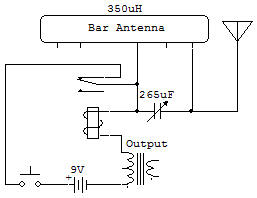
Spark Gap Transmitter

We have been experimenting with radio receivers. What about the other end of the signal, the transmitter?
Can we experiment with that, too? Yes, we can!
First, let's go back to the early circuits. When radio was first invented, there was no way to transmit voice sounds. All they could send was noise, and then they used a key to send the noise in dots and dashes (Morse Code).
Those early transmitters were called "spark gap" transmitters. Actually all they did was generate a lot of electricity which was made to jump a gap (between two metal objects, like two large iron balls) and they found that this produced radio signals. There are two major concepts of electronics which are applied to obtain operation with a spark gap transmitter.
One is the fact that the energy stored in an electromagnetic field can be used to generate a spike of electrical energy which contains many frequency components. We all experience this characteristic of inductive circuits, when we hear clicks and pops in a receiver as a nearby electrical circuit is turned OFF.
The primary example of this is obtained from a gasoline engine which does not have radio resistance ignition wire or noise suppressing type spark plugs. The energy radiated from these ignition systems will even cause "snow" on a television screen.
The second major concept is that a high-Q tank circuit will accept energy at its resonant frequency and reject energy far removed from its resonant frequency. At the resonant frequency the energy is passed back and forth between the coil and Capacitor. This action has been explained by some with the pendulum analogy. That is, if you bump a pendulum it will begin to swing back and forth at its own resonant rate as determined by the physical mass.
Likewise, if you shock an electrical circuit with a sudden pulse of current it will resonate at its own resonant point as determined by the size of the coil and Capacitor in the circuit. The circuit here uses the Relay field coil to provide high inductance which then causes a surge of energy as the Relay contacts open and form a gap, this surge jumps across this gap in the form of a spark.
The radio tank circuit uses part of the inductive circuit which is common to both circuits to pick up some of the energy. This energy then causes a few cycles of oscillation to occur in the tank circuit. This action is repeated as the Relay contacts continue to vibrate back and forth like a door bell buzzer.
The radiated signal as picked up on a nearby radio sounds like a raspy buzz. The telegraph key allows you to send Morse Code with this transmitted signal. The main problem with this circuit is that the arcing and sparking at the contacts of the Relay tend to destroy the contacts after only a short time.
